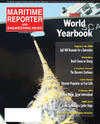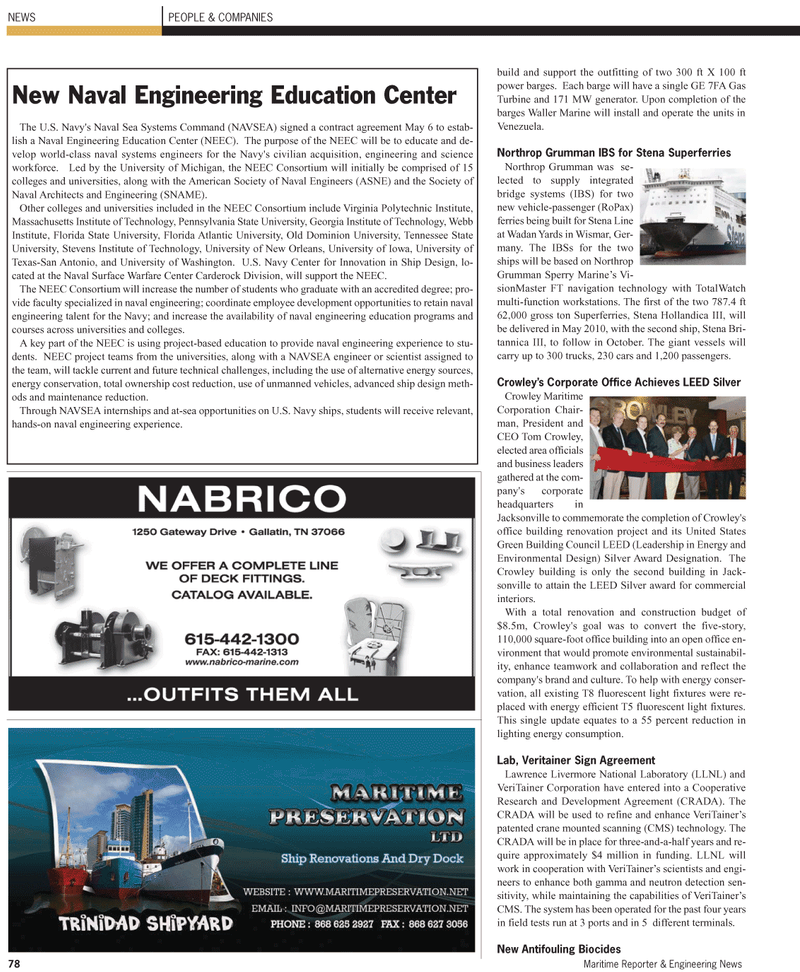
Page 78: of Maritime Reporter Magazine (June 2, 2010)
Read this page in Pdf, Flash or Html5 edition of June 2, 2010 Maritime Reporter Magazine
78 Maritime Reporter & Engineering News build and support the outfitting of two 300 ft X 100 ft power barges. Each barge will have a single GE 7FA Gas
Turbine and 171 MW generator. Upon completion of the barges Waller Marine will install and operate the units in
Venezuela.
Northrop Grumman IBS for Stena Superferries
Northrop Grumman was se- lected to supply integrated bridge systems (IBS) for two new vehicle-passenger (RoPax) ferries being built for Stena Line at Wadan Yards in Wismar, Ger- many. The IBSs for the two ships will be based on Northrop
Grumman Sperry Marine’s Vi- sionMaster FT navigation technology with TotalWatch multi-function workstations. The first of the two 787.4 ft 62,000 gross ton Superferries, Stena Hollandica III, will be delivered in May 2010, with the second ship, Stena Bri- tannica III, to follow in October. The giant vessels will carry up to 300 trucks, 230 cars and 1,200 passengers.
Crowley’s Corporate Office Achieves LEED Silver
Crowley Maritime
Corporation Chair- man, President and
CEO Tom Crowley, elected area officials and business leaders gathered at the com- pany's corporate headquarters in
Jacksonville to commemorate the completion of Crowley's office building renovation project and its United States
Green Building Council LEED (Leadership in Energy and
Environmental Design) Silver Award Designation. The
Crowley building is only the second building in Jack- sonville to attain the LEED Silver award for commercial interiors.
With a total renovation and construction budget of $8.5m, Crowley's goal was to convert the five-story, 110,000 square-foot office building into an open office en- vironment that would promote environmental sustainabil- ity, enhance teamwork and collaboration and reflect the company's brand and culture. To help with energy conser- vation, all existing T8 fluorescent light fixtures were re- placed with energy efficient T5 fluorescent light fixtures.
This single update equates to a 55 percent reduction in lighting energy consumption.
Lab, Veritainer Sign Agreement
Lawrence Livermore National Laboratory (LLNL) and
VeriTainer Corporation have entered into a Cooperative
Research and Development Agreement (CRADA). The
CRADA will be used to refine and enhance VeriTainer’s patented crane mounted scanning (CMS) technology. The
CRADA will be in place for three-and-a-half years and re- quire approximately $4 million in funding. LLNL will work in cooperation with VeriTainer’s scientists and engi- neers to enhance both gamma and neutron detection sen- sitivity, while maintaining the capabilities of VeriTainer’s
CMS. The system has been operated for the past four years in field tests run at 3 ports and in 5 different terminals.
New Antifouling Biocides
NEWS PEOPLE & COMPANIES
New Naval Engineering Education Center
The U.S. Navy's Naval Sea Systems Command (NAVSEA) signed a contract agreement May 6 to estab- lish a Naval Engineering Education Center (NEEC). The purpose of the NEEC will be to educate and de- velop world-class naval systems engineers for the Navy's civilian acquisition, engineering and science workforce. Led by the University of Michigan, the NEEC Consortium will initially be comprised of 15 colleges and universities, along with the American Society of Naval Engineers (ASNE) and the Society of
Naval Architects and Engineering (SNAME).
Other colleges and universities included in the NEEC Consortium include Virginia Polytechnic Institute,
Massachusetts Institute of Technology, Pennsylvania State University, Georgia Institute of Technology, Webb
Institute, Florida State University, Florida Atlantic University, Old Dominion University, Tennessee State
University, Stevens Institute of Technology, University of New Orleans, University of Iowa, University of
Texas-San Antonio, and University of Washington. U.S. Navy Center for Innovation in Ship Design, lo- cated at the Naval Surface Warfare Center Carderock Division, will support the NEEC.
The NEEC Consortium will increase the number of students who graduate with an accredited degree; pro- vide faculty specialized in naval engineering; coordinate employee development opportunities to retain naval engineering talent for the Navy; and increase the availability of naval engineering education programs and courses across universities and colleges.
A key part of the NEEC is using project-based education to provide naval engineering experience to stu- dents. NEEC project teams from the universities, along with a NAVSEA engineer or scientist assigned to the team, will tackle current and future technical challenges, including the use of alternative energy sources, energy conservation, total ownership cost reduction, use of unmanned vehicles, advanced ship design meth- ods and maintenance reduction.
Through NAVSEA internships and at-sea opportunities on U.S. Navy ships, students will receive relevant, hands-on naval engineering experience.

 77
77

 79
79
